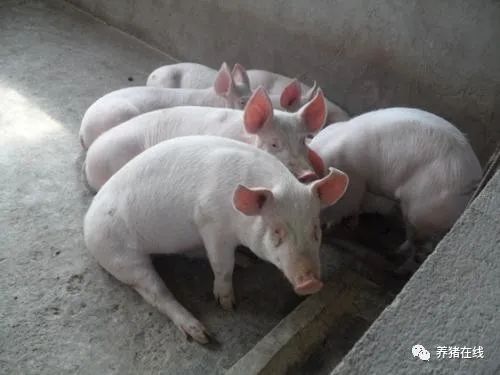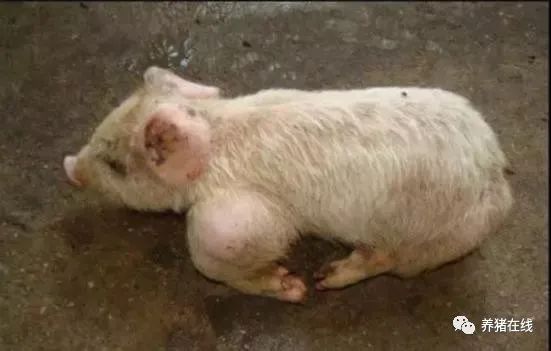How is it that a pig can't stand up or walk on its legs?
Suffering from pigs lying on the ground can not afford to grasp the tail can still stand, but walking difficulties for "leg crutch", grasp the tail can not stand for "paralysis".
Leg crutches are caused by pain, often caused by damage to bones, muscles, ligaments, tendons (commonly known as "tendons"), joints and hooves.
Paralysis is caused by nerve, mostly due to nerve center, neuromuscular junction or motor nerve dysfunction.
Leg crutches
1. Identify the cause of pig leg crutches from the injured site:
(1) Bone:
Including periosteum, bone and bone marrow, mainly composed of collagen and other organic substances and calcium phosphate and other inorganic substances, the former determines the toughness of bone, the latter determines the hardness of bone.
Bone damage is common in:
Bone fracture and fracture caused by external force during ① transformation, showing pain, swelling, subcutaneous congestion and refusing to stand.
The hip dislocation caused by the slippery ② cage shows that one side of the hip is bulging, can still walk after driving, and likes to lie down.
Osteomalacia or rickets caused by disturbance of calcium and phosphorus metabolism in ③, characterized by stumbling, no tenderness, physical deformity and so on.

(2) muscle:
The basic structure and functional unit of muscle fiber (muscle cell) contraction is sarcomere, which is formed by the intertwining of myosin (coarse myofilament) and actin (fine myofilament). The two slide each other to complete muscle contraction.
Muscle damage is common in:
① load (such as boar overweight at the time of intercourse) or slipping leads to extreme limb extension and strain, showing local pain, tenderness, muscle tension, hardness, sometimes accompanied by hematoma and difficulty in walking.
Muscle spasms caused by strenuous exercise in ② (commonly known as cramps, continuous involuntary stiff contraction of muscles), characterized by sudden lying on the ground, struggling, forced to stand and continue to exercise, the phenomenon of claudication gradually alleviated
(3) ligament or tendon toughness:
The ligament is a white ribbon of connective tissue, which is tough and elastic, which is used for the connection between bone and bone, and can fix the position of organs such as liver, spleen and kidney.
Tendons are corded or membranous dense connective tissue at both ends of the abdomen, which are used to connect bones to muscles; tendons can transmit electrical signals by nerves but not ligaments.
Ligament and tendon injuries are common:
A strain caused by a fall during a bite or drive, showing limited bending, marked tenderness and stiff tension, accompanied by intra-tissue bleeding or hematoma
(4) Joint:
The joint is composed of articular surface, articular capsule and articular cavity to realize the indirect connection between bone and bone.
Joint injuries are common in:
Arthritis caused by ① streptococcus, porcine erysipelas, etc., showing pimple and tenderness in the joints, empyema in severe cases, and bone deformation in a long time.
The joint cavity effusion caused by ② Haemophilus parasuis shows swelling of the whole leg, difficulty in flexion when walking, and goose-shaped pace.
③ poor quality protein raw materials caused by gout, uric acid deposition in the joint cavity, showing thick joints, walking carefully.
Joint sprain caused by ④ climbing ring shows joint swelling, severe pain, limited movement, subcutaneous congestion of the joint but no fluid in the joint after acupuncture.
Rheumatism caused by cold and damp in ⑤ coop is related to autoimmune disorder. Rheumatic factors and immunoglobulins form immune complexes deposited in the joints, showing lying like lying, no tenderness points, and the symptoms are gradually alleviated after forced exercise.
(5) hoof:
The hoof is composed of a dead tissue shell and living cells that can produce keratin, including a very hard horny outer wall, a hard foot bottom and a softer hoof ball angle, which wraps the hoof ball, which can ease the pressure on the hoof, like a cushion.
Hoof horny shell and keratinocytes do not have blood vessels and nerves, can not feel pain; the dermis has blood vessels to supply keratinocyte nutrition, and nerves, can feel pain.
Damage to the hoof:
Due to disease factors such as foot-and-mouth disease, foot-and-mouth disease and other foot injuries and dermis caused by biotin deficiency.
two。 Identify pig leg crutches from the cause:
(1) broken toe and hoof: it is common in foot-and-mouth disease.
(2) cracked or deformed hooves: common nutritional factors such as biotin deficiency
(3) wound type: common in stab wounds, scratches, bites, tendon or muscle strain, bone damage or dislocation, inappropriate intramuscular injection, etc.
(4) inflammatory type: common in streptococcus, paraswine, swine erysipelas, mycoplasma infection, etc.
(5) Metabolic disorders: common in gout, etc.
(6) allergic type: common in rheumatism, etc.
3. Principles for the treatment of leg crutches:
Non-steroidal antipyretic analgesics such as cephalosporin, lincomycin, sulfonamide and non-steroidal antipyretic analgesics are commonly used for fuzzy treatment.
II. Paralysis
The movement of the limbs is controlled by nerves, the lowest control center is in the spinal cord, the highest control center is in the cerebral cortex, and there are different levels of central participation in the middle, and the related nerve center, peripheral nerve and neuromuscular junction are damaged. the loss of voluntary motor function is paralysis.
Divided into monoplegia (one limb paralysis), hemiplegia (one limb paralysis), cross paralysis (left forelimb right hindlimb or right forelimb left hindlimb paralysis), quadriplegia, paraplegia (two forelimbs or two hindlimbs paralysis) and so on.
1. Common types of paralysis:
(1) Spinal paralysis: such as porcine infectious encephalomyelitis, showing persistent spastic paralysis below the injury level.
(2) Cerebral paralysis: such as encephalitis caused by pseudo-rabid dogs, showing coma, vomiting, meningeal irritation, tremor and so on.
(3) Peripheral nerve damage: such as polyneuritis caused by vitamin B2 deficiency, loss of motor sensation in the innervated area, muscle relaxation, atrophy, disappearance of reflex and temporary paralysis.
(4) Neuromuscular joint paralysis: such as aminoglycoside poisoning, showing systemic paralysis and dyspnea.
(5) muscle paralysis: such as postpartum paralysis of sows, showing normal mental appetite, lying on the ground, and acupuncture reflexes.
two。 Principles for the treatment of paralysis:
Either find out the cause and cause of treatment, or eliminate
In order to relieve the symptoms, sodium sulfamethoxine + troxerutin intramuscular injection is often used.
- Prev

The pig suddenly can not stand up, find the right reason and then treat it!
The pig suddenly can not stand up, find the right reason and then treat it!
- Next

What disease is swollen pig joint, how to prevent and cure effectively?
What disease is swollen pig joint, how to prevent and cure effectively?
Related
- On the eggshell is a badge full of pride. British Poultry Egg Market and Consumer observation
- British study: 72% of Britons are willing to buy native eggs raised by insects
- Guidelines for friendly egg production revised the increase of space in chicken sheds can not be forced to change feathers and lay eggs.
- Risk of delay in customs clearance Australia suspends lobster exports to China
- Pig semen-the Vector of virus Transmission (4)
- Pig semen-the Vector of virus Transmission (3)
- Five common causes of difficult control of classical swine fever in clinic and their countermeasures
- Foot-and-mouth disease is the most effective way to prevent it!
- PED is the number one killer of piglets and has to be guarded against in autumn and winter.
- What is "yellow fat pig"? Have you ever heard the pig collector talk about "yellow fat pig"?

